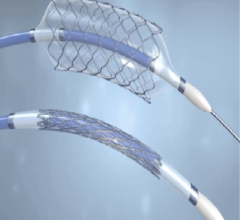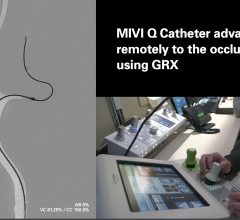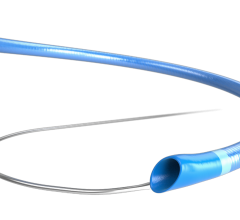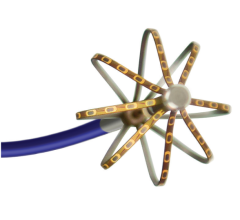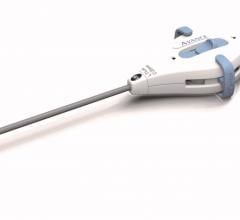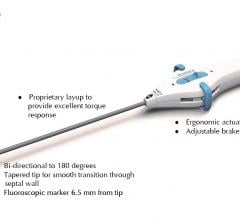
Jim Rushworth, vice president and general manager of Terumo Interventional Systems (TIS),
Beginning April 1, Terumo officially launches its own, full-scale marketing and sales program for all its products in the U.S. — including the flagship Glidewire catheter line — which have formerly been sold under the Boston Scientific name. Diagnostic & Invasive Cardiology wanted to know how this change will impact cardiologists and all peripheral interventionalists, and what else Terumo is doing to make doctors’ jobs a little easier.
In the U.S. healthcare market, your products have been identified with the Boston Scientific name, but that’s about to change. What was really at the crux of Terumo’s decision to take possession of its own selling rights in this country?
We are doing this, to put it very succinctly, in order to get closer to our customers. We have been at arm's length from the customers in the U.S. We've got to be in a position where we can understand more thoroughly and exactly what it is the market needs.
We’ve been successfully growing our product line and bringing solutions to physicians in other markets, but we weren't always able to do those same things here in the U.S. because of how the relationship with Boston Scientific was set up. So we looked at how we were running our business; we looked at the importance of being close to that customer.
We also looked at the fact that the U.S. is, in many ways, considered the innovator, the thought leader — to grow our business here and globally, we need to be closer. We made this strategic decision to go ahead and establish ourselves in this market.
How will the change affect customers — what’s in it for them?
We have gotten a very good reaction from our customers. They are looking forward to establishing this relationship with us and looking forward to understanding better how we can help them.
As we go out and talk to our customers, they respond very favorably. They're appreciative of us being their wire experts.
When we were at Johns Hopkins for a meeting, one of the physicians asked me about a wire that he had seen — he wasn't sure what the wire was, but he knew it was a Terumo neurowire, which had previously been sold through a division of Boston Scientific. He had seen the wire and knew he wanted it. Because Terumo is now selling these products, we can be that hydrophilic wire expert for him. I didn’t have to tell him he would have to call somebody else.
Instead, I was in a position to make a lot of recommendations with regard to solutions. I think that captures the essence of what we are going to be able to do in the market place and how physicians are looking to us to be that resource.
What’s this hydrophilic coating on the Glidewires all about?
Terumo was the innovator in this technology, which we first introduced to the U.S. in 1987. Before this, all wires were a stainless steel — a core wire with another wire wrapped radially around it. Stainless steel wires weren't very lubricious and wouldn't slip through the arteries very well.
Then there were Teflon coated wires to help the lubricity, but still, they were not real lubricious.
What Terumo did was introduce a completely new construction and a completely new surface to wires. And it really helped spur the growth of interventional procedures. When we launched this product, we came to the market with a Nitinol core wire as opposed to a stainless steel core wire. The Nitinol doesn't kink. One of the problems with the stainless steel wire was that once you bend it beyond a certain point, it stays bent. Once that happens, it really doesn't want to move forward.
But Terumo uses Nitinol, which is a shape-memory alloy comprised of titanium and nickel. If you wrap a stainless steel wire around your finger as tightly as you can, it stays in that particular shape. If you wrap a Terumo wire around your finger as tightly as you can, as soon as you let go, it springs back to a straight wire.
What that means is, as you're going through really torturous anatomy, the wire doesn't get shaped or kinked; it continues to move forward more easily.
We also coat that Nitinol core with a polyurethane jacket, a kind of plastic that is bonded to the Nitinol core and acts as a surface that allows the hydrophilic coating to be bonded to the wire.
Then we apply the hydrophilic coating, an extremely slippery substance that allows the wire to glide effortlessly through the vasculature. Since our introduction, we have really been the gold standard.
Over the years, I have had many physicians tell me, “Jim, without this wire, interventional procedures would not be what they are today.” It has really helped shape interventional therapy worldwide.
It was an unorthodox approach to making wires, but the proof has been in how long this product has been a market leader.
Now that Terumo is ‘coming out’ so to speak, launching this public presence in the U.S., are you going to introduce some products that you have previously only marketed abroad?
Yes, we certainly are. We have a whole line of coronary products or interventional cardiology products that we sell in Asia and in Europe — a wide line of products that we don't have in the U.S. yet. We'll have to go through the normal channels to obtain FDA clearance, but that has never been an issue or problem.
And what’s in the Terumo bullpen?
We are trying to understand from our customers what else we need to do to help them and facilitate their ability to practice medicine. We are doing a lot of activity behind the scenes right now to understand that and get our R&D and manufacturing resources back in Japan really primed and ready to go with new products.
Last December, we announced our partnership with Massachusetts General Hospital involving a technology called OFDI (Optical Frequency Delayed Imaging), which is a step beyond OCT (Optical Coherence Tomography). We are looking at some technologies that really go a step beyond, giving a near histologic resolution of the lesion that you are looking at. It's fiberoptic based, and you can integrate this technology with many different wires and catheters.
Given our competency in building wires and catheters, we think this technology will enable further diagnostic capabilities and, therefore, further therapeutic intervention. These are some of the technologies we are looking at on the horizon.

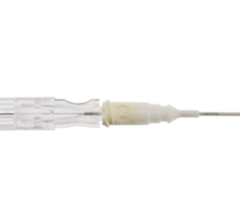
 April 03, 2024
April 03, 2024 

